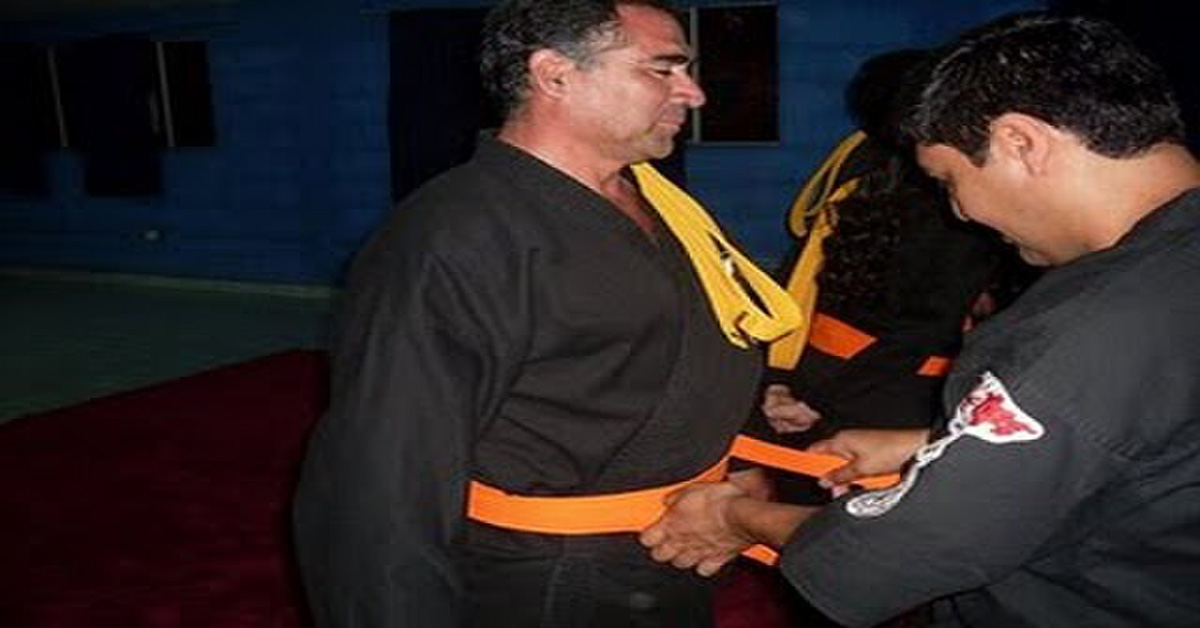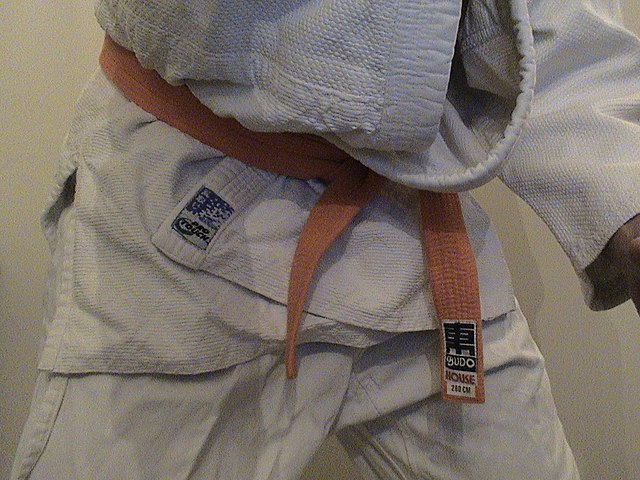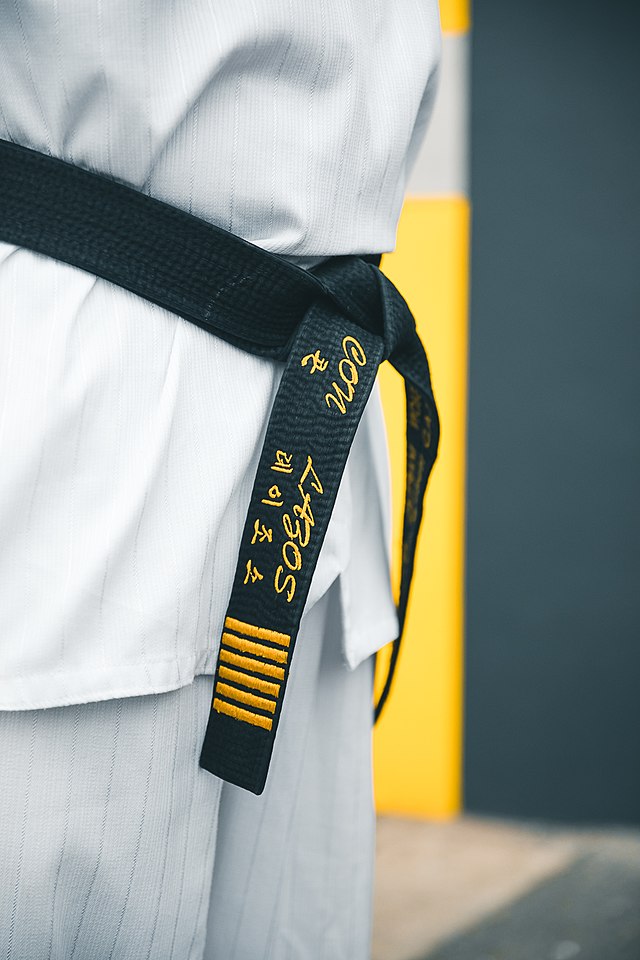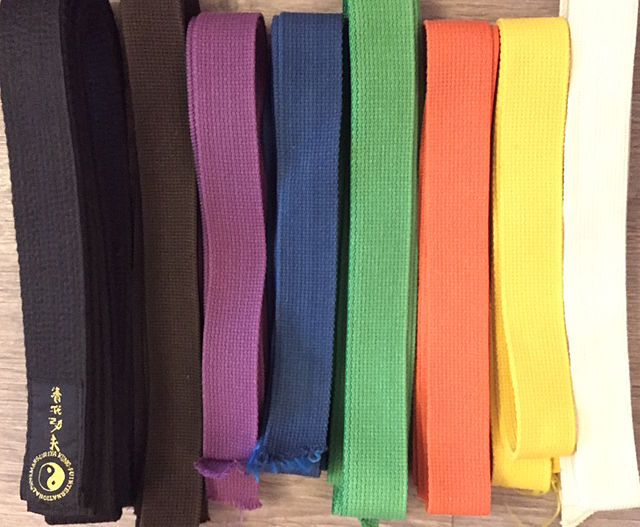Martial Arts Belts & Ranking System

Many fighting styles use martial arts belts to separate the ranks of practitioners. Have you ever wondered how many of them use martial arts belts?
Check out the full list of styles that use martial arts belts or any ranking system below. Also, including the number of martial arts belts in each system and how long it takes to go through each ranking.
How Many Fighting Styles Use Martial Arts Belts?
Numerous fighting styles use martial arts belts to show the rank of students. With the various hybrid forms of the main fighting systems, there’s no telling how many ranking systems exist.
Some of the most known fighting styles that use martial arts belts include:
- Judo
- Karate
- Taekwondo
- BJJ
- Kuk Sool Won
- Forms of Kung Fu
- Capoeira
- Krav Maga
- Savate
- Wing Chun
What is the Color Order of the Martial Arts Belts Signify?
Each fighting style that uses martial arts belts to classify ranks uses different colors that signify different meanings. Generally, new students start out at white and work through mid-rank colors before getting the top–ranked belt.
In most styles, the first belt in the sequence is a white belt and finished at black, red, or blue.
The History of Martial Arts Belts & Ranking Systems
While using martial arts belts seems like an ancient tradition, the practice of using them isn’t that old. The person credited for coming up with a ranking system using belts was Judo founder Jigoro Kano.
Originally, there were white and black belts in Judo, but Kano thought there needed to be more structure. This was when he began separating his students by different colored belt ranks.
Judo would then inspire other martial arts like Karate, Taekwondo, and BJJ to use martial arts belts. Today, numerous martial arts and hybrid martial arts systems use ranking systems.
What Fighting Styles Don’t Use Martial Arts Belts?
While many fighting styles do use martial arts belts, many don’t. These type of martial arts are sports-based, where accomplishments in competitions determine rank.
The most known styles that don’t use martial arts belts include:
- Wrestling
- Muay Thai
- MMA
- Kickboxing
- Boxing
- Stick Fighting Styles
Some Muay Thai gyms now use ranking systems with armbands, but not all use them. Whether they should be used or not is a hot topic in the Muay Thai community.
The Martial Arts Belts of Each Fighting Style
Judo
Judo was the first self-defense style that implemented the use of martial arts belts. The Judo belt system comprises seven colored martial arts belts that take over 5 years to complete.
- White Belt
- Yellow Belt
- Orange Belt
- Green Belt
- Blue Belt
- Brown Belt
- Black Belt

Karate
We know there are numerous Karate styles that exist, which use different belt systems. For this article, we will use the official martial arts belts recognized by the World Karate Federation.
This ranking system consists of eight different belt colors that students usually advance through in 3 to 5 years.
- White Belt
- Yellow Belt
- Orange Belt
- Green Belt
- Blue Belt
- Purple Belt
- Red Belt
- Brown Belt
- Black Blt
Taekwondo
The Karate ranking system inspired the use of martial arts belts in the art of Taekwondo. When Taekwondo was being formed, they created their own ranking order approved by World Taekwondo.
Like Karate, Taekwondo has various organizations with different belt orders. This article will detail the ranks used by World Taekwondo-affiliated schools.
World Taekwondo has a total of 12 different martial arts belts that take over three years to complete.
- White Belt
- Yellow Belt
- Orange Belt
- Green Belt
- Purple Belt
- Blue Belt
- Sr. Blue Belt
- Brown Belt
- Sr. Brown Belt
- Jr. Black Belt
- Black Belt
(Note: Only Taekwondo students under the age of 16 are given the senior and junior ranks. Adult students do not go through these ranks.)

BJJ
Brazilian Jiu-Jitsu, or BJJ, is a martial art directly descended from Judo. To pay homage to Judo, BJJ creators would also use martial arts belts to signify ranks.
The adult ranking system in BJJ consists of five colored belts that take 5-10 years to complete.
- White Belt
- Blue Belt
- Purple Belt
- Brown Belt
- Black Belt
Kung Fu
Originally, the Kung Fu or Wushu style did not have ranking systems. They used the traditional master-student systems, where the master would tell the students when they were a master.
As different Kung Fu practitioners saw the practicality of ranking systems, some styles would adopt their own. Many styles don’t use martial arts belts but sashes to signify ranks.
The nine-sash system is the most common system used in Kung Fu styles like Sanda.
- White Sash
- Yellow Sash
- Gold Sash
- Orange Sash
- Green Sash
- Blue Sash
- Purple Sash
- Brown Sash
- Red Sash
- Black Sash

Aikido
The Japanese grappling style of Aikido would also adopt the use of martial arts belts from Judo. Aikido creator Morihei Ueshiba created his own ranking system made up of eight ranks.
- White Belt
- Yellow Belt
- Orange Belt
- Green Belt
- Red Belt
- Blue Belt
- Brown Belt
- Black Belt
Most Aikido schools use ranks that look like this, but some schools use different rankings.
Wing Chun
The Kung Fu style of Wing Chun also has its own ranking systems. Different schools of Wing Chun use different ranking systems.
Here is one of the most used martial arts belt systems used by Wing Chun schools that consists of 10 ranks.
- White
- Light Blue
- Medium Blue
- Dark Blue
- Light Brown
- Brown Black
- Grey
- Gold
Hapkido
Hapkido is an effective Korean hybrid style that also uses martial arts belts. The Hapkido belt system comprises six ranks that take around five years to complete.
- White Belt
- Yellow Belt
- Green Belt
- Blue Belt
- Red Belt
- Black Belt
Capoeira
Not every style of this dancing martial art of Capoeira uses martial arts belts, but some do. But, instead of belts, some styles used colored tassels to separate the ranks of students.
The ranking system most used within Capoeira consists of 15 different colored tassels.
Aluno/Student
- Yellow
- Gold
- Yellow/Orange
- Orange
- Orange/Blue
Aluno Graduado(Gradate Student)
- Blue
- Blue/Green
- Green
- Green/Purple
Instrutor(Instructor)
- Purple
- Purple/Brown
Professor
- Brown
- Brown/Red
Mestrando
- Red
Mestre
- Red/White
Krav Maga
Krav Maga has become popular recently and is billed as “the perfect self-defense system.” This Israeli martial art also has its own ranking system.
The martial arts belts most used within Krav Maga consist of six ranks that they call levels.
- Yellow Belt
- Orange Belt
- Green Belt
- Blue Belt
- Brown Belt
- Black Belt
In order to earn a black belt in Krav Maga, a student must be invited by their instructor to test for it.
Kendo
Being a Japanese martial art, the weapon art of Kendo also uses martial arts belts. The Kendo belt system is compromised of dan ranks and various other titles.
- 1st Dan
- 2nd Dan
- 3rd Dan
- 4th Dan
- 5th Dan
- 6th Dan
- 7th Dan
- 8th Dan
- 6-dan(Renshi)
- Renshi 7-Dan(Kyoshi)
- Kyoshi 8-Dan(Hanshi)
Savate
The French kickboxing style of kickboxing is a unique, striking style that uses martial arts belts. Most schools that teach this kickboxing style use a ranking system consisting of 8 ranks.
- Blue
- Green
- Red
- White
- Yellow
- Technical Silver 1
- Technical Silver 2
- Technical Silver 3
Kul Sool Won
The last martial art we’ll cover that uses martial arts belts is the Korean art of Kul Sool Won. The Kul Wool Won grading system consists of seven different belts that takes 5-10 years to complete.
- White Belt
- Yellow Belt
- Blue Belt
- Red Belt
- Brown Belt
- Black-Brown
- Black Belt






